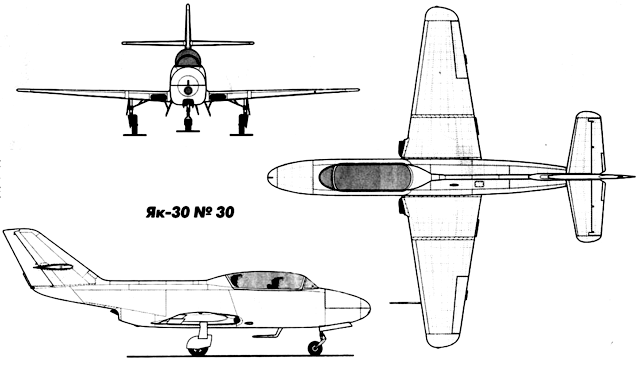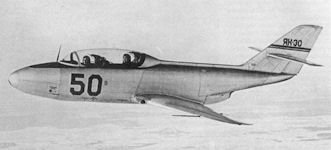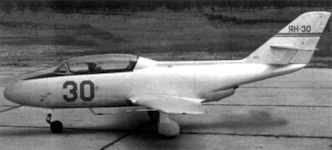Yak-104 / Yak-30 [second] Magnum trainer
With the advent of the Soviet Union jet, naturally raised the question of the preparation of flight crews for these machines. As for the Air Force and Civil Aviation. Traditional circuit training pilots - aircraft initial training + training aircraft (machine with dual controls) - broke down due to lack of fusion with a jet engine. In 1957, the Design Bureau started designing jet TCB, the designation Yak-104. As the power plant considered R5-300 engines based on AM-5, then R5-45 N.G.Metshvarishvili design with thrust 1000 kgf. Draft aircraft project was carried out in February-March 1957 and considered by the Air Force July 17, 1957, and in November the same year passed the test models in a wind tunnel TsAGI T-106M-led G.S.Byushgensa. In August 1957 the aircraft mock-up was built, however, in connection with the termination of fine-tuning the engine R5-45 construction of the prototype was stopped.
On July 31, 1958 the USSR Council of Ministers issued a decree of on the construction - 854-404 Yak-104 (future Yak-30), but with the engine RU19-300. Almost simultaneously in Poland and Czechoslovakia began to develop its own aircraft of similar purpose: TS-11 "Iskra" on the company PZL and L-29 "Dolphin" on the company Aero. In 1959, the deputy minister of the aviation industry of the USSR A.A.Kobzarev reports the initiative of representatives of the Air Force to stop work on the Yak-104 aircraft and engine RU19-300 and buy Czech L-29 training.
In 1960, two experimental Yak-104s were built - the first on May 15 (board "30") and the second on July 21 (board "50"). The lead designer was K.V. Sinelshchikov, acting as Deputy General Designer - A.S. Yakovlev . In the same year, the Yak-104 was renamed the Yak-30.
On August 30, 1960 state tests was transferred first Yak-30, and soon a second. In total, these four aircraft involved, as on the order of GKAT (State Committee for Aviation Technology). State tests ended August 14, 1961 At the conclusion of the Air Force Institute of the Yak-30 was recommended for service. This recommendation signed by Chief of the Air Force, Air Chief Marshal KA Vershinin. Right on schedule in February 1962, it has been worked out and transferred to the plant - 116 drawings and technical documentation for series production. The new plant in Tyumen was launched in a series of motor RU19-300. The Yak-30 is prepared for display in Paris, but sending it to the exhibition did not take place.
Of the four built Yak-30, the two are stored in the bureau, one exhibited in the Air Force Museum in Monino. A Yak-30, lost in the crash of September 8, 1965, which killed R.M.Shihina, world champion in aerobatics, and V.M.Volkov. Too vigorous implementation of the aileron barrels on which airplane, there was a destruction of the wing consoles has not been tested. Shikhin, accustomed to heavy control by the ailerons on the Yak-18, did not have time to learn a very easy control of the Yak-30.
In 1971, the Yak-52 project was proposed (the first aircraft with this designation) based on the Yak-30, but with a new engine AI-25. The plane had two options: double training and double aerobatic. Yak-52 was supposed to compete with the successor to L-29, who had the same engine AI-25. However, further work on the Yak-52 was not undertaken.
| Modification | Yak-30 | |
| Wingspan, m | 9.39 | |
| Aircraft Length m | 10.14 | |
| Height, m | 3.10 | |
| Wing area, m2 | 14.30 | |
| Weight, kg empty aircraft | 1514 | |
| maximum take-off | 2400 | |
| engine's type | 1 THD RU-19-300 | |
| Thrust, kgf | 1 x 900 | |
| Maximum speed km / h | 660 | |
| Cruising speed, km / h | 548 | |
| Practical range, km | 500 | |
| Practical ceiling, m | 14000 | |
| Crew | 2 |

Yak-104 (the second with the same name)
The Yak-V was the first VTOL project, created at the Design Bureau, based on the already flying Yak-30 interceptor. The aircraft was supposed to install R-19 engines. The air intake was removed from the nose and made two side. In the late 1950s, the OKB-115 team headed by A.S. Yakovlev. A prerequisite for the implementation of the plans was the emergence of a light and compact turbojet engine R-19-300. In 1960, Yakovlev came out with the proposal to develop the Yak-104 aircraft. The project provided for the use of the spirit of forced R-19-300 engines with a thrust of 1,600 kgf each as a lifting-marching and one lifting R-19-300 thrust of 900 kgf. It was expected that with a flight weight of 2800 kg and a fuel reserve of 600 kg, the VTOL aircraft would be able to fly at a maximum speed of 550 km / h, climb to a height of 10,000 m and have a range of 500 km with a flight duration of 1 hour 10 minutes. Development of the Yak-104 was abandoned due to its complex liftfans.
|
NEWSLETTER
|
| Join the GlobalSecurity.org mailing list |
|
|
|



